The Dreamer/Characters
This is the character sheet for The Dreamer, in all its Loads and Loads of Characters glory. Warning! Spoilers ahead!
21st - century cast
Beatrice 'Bea' Whaley

Bea Whaley has big dreams for her future. The seventeen year old wants nothing more than to star in theater productions after she graduates. And it seems like it might happen–her Uncle Hercules, a Broadway costume designer, has already introduced her to famous producers, directors and choreographers. She doesn’t care much for books or school work, and would rather spend her time daydreaming, singing, acting, or hanging out with her friends. A bit shy and awkward in social situations, Bea lets herself go when she’s performing, which might the reason she loves the stage so much.
At the start of her senior year, she begins having vivid dreams about the American Revolution. She soon becomes convinced the dreams are real–they always start where the last one ended, and she discovers that some of the events in her dreams actually happened. As she tries to figure out what is happening to her, she pushes away her closest friends and family in order to dive deeper into her dreams, exploring the world of 18th century America and the interesting people she meets there.
- Blessed with Suck/ Cursed with Awesome
- Daddy's Girl
- Damsel in Distress
- Genki Girl
- Green Eyes
- The Gump
- Launcher of a Thousand Ships: Seriously. She's officially with Alan & Ben, may have had a past with Alexander Hamilton, vibes with Nathan Hale, could be with Freddy since they're more or less the same age, Kissing Cousins with her cousin John, etc.
- Laser-Guided Amnesia
- Love Transcends Spacetime: With Alan.
- May–December Romance: With Alan.
- Mental Time Travel: With her dreams.
- Myers-Briggs: INFP
- Ordinary High School Student
- The President's Daughter: More like a really wealthy and important Bostonian Loyalist's daughter.
- Eerie Pale-Skinned Brunette
- Plucky Girl
- Spirited Young Lady
- Spoiled Sweet
- Tsundere: Type B, with her tsun-tsun side usually triggered by Hamilton.
- Raven Hair, Ivory Skin
- Uptown Girl
Benjamin Cato
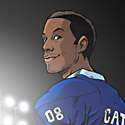
Nineteen year old Ben Cato is a year older than the other seniors, since he repeated a grade in middle school. It was the wake up call he needed, and he decided to stop hanging out with the wrong crowd and take school more seriously. As the starter quarterback on the High School football team, scouts noticed him his junior year. But his season ended abruptly with a severe knee injury. Senior year he continues to play on the team, despite no longer being a contender for a college scholarship. Ben has an overcoming spirit and a constant smile. Rather than allow the change of plans to bring him down, he tries a new direction for his life: acting. He has secretly held an interest in theater, attending all the school plays. From the audience of these productions Ben took notice of the school’s leading actress–Beatrice Whaley. When the two audition together for Romeo and Juliet, he takes a chance and asks her out. And since she’s been waiting five years for him to notice her, she promptly agrees!
- Mr. Fanservice
- Flat Character
- Meaningful Name: Ben's last name is also the name of a famous play, which was a favorite among many patriots. He also shares the name with Jemmy Cato, the leader of the Stono Rebellion.
- Real Men Wear Pink: He does acting, which is considered a 'girly' thing to do.
Elizabeth Winters

Liz Winters and Bea Whaley have been best friends since elementary school. But if they hadn’t bonded then, they might never have become friends at all! The two girls are polar opposites. Where Bea is an explosion of emotions, Liz is reserved and patient. Where Bea is reckless, Liz is cautious. Where Bea speaks her mind without thinking, Liz bites her tongue and keeps her foot out of her mouth. At the beginning of senior year, Bea’s cousin John asks Liz to be his date for the Halloween dance and Liz eagerly agrees, despite fearing Bea’s reaction. John shares some of Bea’s fiery Irish temperament which they get from their parents, and his ability to speak his mind and express himself are attractive to Liz. She wishes she could let loose more, but when she tries to share her opinions, it often blows up in her face.
- Beta Couple: With John.
- The Chick
- The Heart
- Muggle Best Friend
- Myers-Briggs: ISFJ
- Shrinking Violet
- Yamato Nadeshiko: personality - wise.
Yvette Howe

Yvette met Liz and Bea at the end of middle school when she moved to Boston from New Orleans with her single mother. Being wallflowers themselves, the girls welcomed the shy new girl into their exclusive friendship, and the three quickly became inseparable. It didn’t take long, however, for Yvette to fall in love with the trendy fashions of Boston and New York, and she quickly came into her own. She worked hard to get rid of her Creole accent and has become a fashionetta like the best of them. She adds spice and a hint of naughtiness to the trio. Despite remaining close to Liz and especially Bea, Yvette has expanded her social circle and is far more popular than her quiet friends. When Yvette takes a special interest in the dreams that Bea is having, Bea feels she is the one friend she can trust. As a result, their friendship deepens even as Bea pushes everyone else away.
- Black Best Friend: Okay, she's Creole, but the case still stands.
- But Not Too Black: Yvette is Creole, so yeah.
- Meaningful Name: She shares the same last name with Gen William Howe.
- Muggle Best Friend
- Myers-Briggs: ESFP
- Sassy Black Woman: Rather, Sassy Creole Girl.
- Secret Keeper: Yvette is the only person who knows of Bea's dreams.
John Mulligan

John Mulligan is Bea Whaley’s hot headed, loud mouthed, and often tactless cousin. Since Bea’s mother and father work long, tireless hours, John’s parents became second parents to Bea, and as such, he’s practically a brother to her. His father’s flamboyant profession–theatrical costume design–embarrasses him. John wants to have a respectable career, and has set his mind on attending Columbia University to study law. Luckily, learning comes easily to him–a bit too easily, however, and being naturally smart has allowed him to become a lazy smart alec. He decides to ask Liz Winters to the Halloween dance, despite being Bea’s best friend, because after spending so many years around his cousin, a girl with a bit more poise and restraint is a breath of fresh air.
- Beta Couple: With Liz.
- Brilliant but Lazy
- Fiery Redhead
- Myers-Briggs: ENTP
18th - century cast
Major Allen Warren
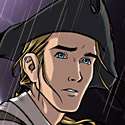
Orphaned at the age of ten, Alan Warren’s Aunt Mary raised him along side his cousins on their apple farm in Roxbury, Massachusetts. Alan’s oldest cousin, Dr. Joseph Warren had left home for Boston to start a medical practice, and there he discovered liberty, politics and Samuel Adams. Only fifteen at the time, Alan quickly got caught up in his cousin’s political protests and joined Sam Adams’ Sons of Liberty, much to his aunt’s dismay. Alan used his inheritance, at only eighteen, to buy an orchard close to home and become an apple farmer himself. But he stayed connected to Boston, and the growing political strife there, by attending town meetings and participating in their protests. As a member of the Roxbury Militia, Alan Warren fought in the Battles of Lexington and Concord, and also at the Battle of Bunker Hill where he defended the Rail Fence with Captain Thomas Knowlton. Knowlton took notice of him and asked Alan to enlist in the new Continental Army as an officer in his company. But before he gave an answer, the British evacuated Boston. And when the American troops entered the city, Thomas Whaley, the father of a high society Bostonian girl Alan had fallen in love with, hunted him down. British soldiers had kidnapped his daughter Beatrice and taken her aboard General Howe’s ship. If Alan could rescue her, Mr. Whaley would give him anything he asked–despite their previous political and economic differences. Alan Warren promised to bring her home, accepted the offer to join Knowlton’s Rangers, but declined the commission, wanting as little responsibility as possible so he could leave to rescue Beatrice the first chance he got.
- Achilles' Heel: Beatrice, and tuberculosis.
- Action Hero
- Always Save the Girl: Played straight with Alan Warren wanting to send Bea Whaley back to Boston.
- Badass
- Chick Magnet
- The Determinator
- Dressing as the Enemy: Alan dresses up as a redcoat in order to rescue Beatrice from Gen. Howe.
- Mr. Fanservice
- Farm Boy
- Hair of Gold
- The Hero
- Jail Bait Wait: Alan waits for Bea to be of proper age before he can court her.
- Love Makes You Crazy: Seriously. That stunt he pulled in the beginning of the comic? Totally craycray.
- Love Transcends Spacetime: With Beatrice.
- Manly Men Can Hunt
- Marty Stu: Some fans argue that he's one of these, but YMMV.
- May–December Romance: With Beatrice.
- Myers-Briggs: ISTP
- Officer and a Gentleman
- Parental Abandonment
- The Slacker: Before the war, Alan was perfectly content to be a dirt poor apple farmer.
- Victorious Childhood Friend: Alan has known Beatrice since her early teens.
- Wife Husbandry: Alan does this with Bea, which of course is rather squicky to say the least.
- Case of Values Dissonance.
Captain Alexander Hamilton
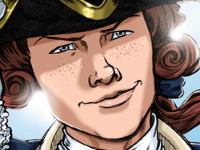
Alexander Hamilton was born in Nevis in The British West Indies, and was born out of wedlock to his mother, Rachel Faucette Lavien, and Scottish nobleman James Hamilton. At the age of ten, Alex's father abandoned the family, and two years later his mother died, leaving he and his older brother James Jr. virtually orphaned. The only thing young Alex had were his mother's books, which he poured over ravenously. These books influenced him and his writing style, and soon he would be publishing poems and hymns in the local newspaper, while working as a store clerk for a local trade-and-charter company in St. Croix. His talents caught the eye of the established gentry of the island, and sent him off on a scholarship to King's College in New York. In New York, he published many political essays in the local newspaper, and lived with Hercules Mulligan, Beatrice Whaley's uncle, and soon got to know Beatrice. In 1775, Alex dropped out of college and volunteered in a New York militia company called the Hearts of Oak. Hamilton studied military history and tactics on his own and achieved the rank of lieutenant. Under fire from HMS Asia, he led a successful raid for British cannon in the Battery, the capture of which resulted in the Hearts of Oak becoming an artillery company thereafter. Through his connections with influential New York patriots like Alexander McDougall and John Jay, he raised the New York Provincial Company of Artillery of sixty men in 1776, and was elected captain.
- Badass Bookworm: He may only be 5'7, but he can kick your ass.
- Broken Hero
- The Charmer: That picture alone should make you quiver.
- Chick Magnet
- Cultured Warrior
- Dark and Troubled Past: Let's break it down: When he was a teenager, in the space of a few years,
- his mother died,
- his father vanished,
- his aunt, uncle, and grandfather also died,
- his cousin committed suicide, and
- Alexander and his brother were disinherited and left penniless orphans.
- And lest us not forget that James Hamilton might not even have been his father in the first place (the honor might go to a gentleman by the name of Thomas Stevens).
- Disappeared Dad
- Ensemble Darkhorse: When he first arrived in the pages of the comic in issue #9, he immediately became a favorite.
- Mr. Fanservice
- Estrogen Brigade: Proud member.
- Fiery Redhead
- Gentleman and a Scholar
- Gentleman Snarker
- Heroic Bastard: But his opponents would rather say he's a Bastard Bastard.
- Historical Domain Character
- In-Series Nickname: He's called Captain Fancy Pants by Nathan behind his back.
- Ivy League: He went to Kings College a.k.a Columbia University
- The Lancer
- Large Ham: come on, it was coming!
- Myers-Briggs: ENTJ
- New Old Flame: There are hints that he and Bea were once in a relationship.
- Officer and a Gentleman
- Parental Abandonment
- Red Hair and Freckles
- Redheaded Hero
- Sixth Ranger
- Stepford Snarker
Captain Nathan Hale

Pious parents sent young Nathan Hale to Yale College at the age of 14, hoping he’d pursue the ministry. But at Yale he discovered he had a gift for the oratory, and when he graduated in 1773, became a school teacher instead. In New London, Connecticut, where he got a job as a school master, he held special early morning summer classes for women, believing they had as much right to an education as men. (The women were, perhaps, more interested in their handsome teacher, than in their teachings, despite the ugly scar a gunpowder burn had left on his forehead.) After fighting broke out in the neighboring Massachusetts Bay colony on April 19, 1775, Nathan, filled with a sense of patriotic duty, joined in the army as a first lieutenant. But to his dismay, his Connecticut company did not arrive in Boston until after the Battle of Bunker Hill, and for the next year Nathan had little to do while the Americans laid siege to Boston. Desperately seeking some action, he requested a transfer. Now a Captain, his request was granted, and he was transferred to an elite group known as Knowlton’s Rangers. When some of the men in his company embarked on a mission to light fire to an American ship and send it sailing toward two large British warships on the Hudson river, Nathan alerted his new friend Alan Warren to use the spectacle as a diversion to get on board the Eagle–General Howe’s personal ship–and rescue Beatrice Whaley.
- Badass Bookworm: Nathan is one of these.
- Badass Teacher
- Butt Monkey: His Colonel doesn't think he's competent enough, he gets beat up by Alan for trying to apologize, he has to escort Bea and humor her crazy schemes, and he hasn't even seen any battles.
- Celibate Smart Guy
- The Chick: A chick who can fight and can set a ship on fire.
- Chick Magnet
- Cultured Warrior: Played straight with Nathan, considering he graduated from Yale with honors and was a school teacher before he enlisted as an officer.
- Distinguishing Mark: He has a mole on his neck, and a powder burn on his forehead.
- Mr. Fanservice
- Estrogen Brigade: Nathan has a very large fanbase concerning this trope.
- Face Death with Dignity
- Genius Book Club: Nathan is often seen reading the play Cato.
- Gentleman and a Scholar
- The Heart
- Heroic Sacrifice
- Historical Domain Character
- Historical Hero Upgrade: Justified, since he was pretty cool.
- Ivy League: Nathan is a graduate of Yale University.
- Myers-Briggs: ENTP
- Officer and a Gentleman
- Sacrificial Lion
- Sesquipedalian Loquaciousness: Nathan often invokes this trope.
- The Smart Guy
- Too Cool to Live
Lt. Colonel Thomas Knowlton

Thirty six years old, handsomely rugged, and a veteran of the French and Indian war, Thomas Knowlton fit the bill of an ideal officer in the Continental Army. After the battles of Lexington and Concord, Captain Knowlton and his company of 200 men from Connecticut were the first troops from his colony to arrive as reinforcements in Boston. When the Americans set out in the middle of the night to dig trenches at Charleston on Bunker Hill, Knowlton and his men participated. As the sun rose, better revealing their surroundings, it became obvious that the British could easily sweep around the American redoubt and attack from behind. To prevent this, Knowlton and his men built up defenses along a rail fence, connecting Breed’s Hill to the Mystic River, cutting off any potential British flanking maneuvers. Knowlton’s men were so successful at holding off their opponents that after the third attempt to storm the rail fence, General Howe was the only British officer still standing. Congress promoted him to Lieutenant Colonel, and put him in charge of a unique group of fighters called “Knowlton’s Rangers.” The Rangers would be entrusted with the most difficult reconnaissance missions, earning their nickname “Congress’s Own.”
- Colonel Badass: Col. Knowlton, obviously. Being the leader of Knowlton's Rangers, the first organized intelligence organization in the U.S. Army certainly helps.
- Cool Old Guy: Okay, he isn't that old, but he is pretty cool.
- Da Chief
- A Father to His Men
- Historical Domain Character
- Killed Off for Real
- Lantern Jaw of Justice
- The Men First
- Mentor Occupational Hazard
- Minor Major Character
- Myers-Briggs: ESTP
- Officer and a Gentleman: More like a disgruntled officer with a heart of gold, but a gentleman nonetheless.
- Old Soldier
- Perma-Stubble
- Team Dad
- Too Cool to Live
Private Frederick Knowlton

When Captain Thomas Knowlton marched north for Boston with the 3rd Connecticut, he left his fifteen-year old son at home. So rather than witness them himself, young Frederick Knowlton had to read about his father’s heroic deeds at Bunker Hill and Charlestown in the papers. For the next year while Thomas Knowlton watched over his troops, Frederick watched over his mother, their farm, and his six younger siblings. But when General Howe and the British forces evacuated Boston, the Continental Army marched south. And on the way, Major Thomas Knowlton stopped at Ashford to visit his family, and to collect the then sixteen year old Freddy for service in the 20th Continental Line. His inconsolable wife barely relented, but ultimately the young man set off for New York City with his father to endure a long, hot summer digging trenches with the other privates. Used to being in charge after a year of managing his family’s affairs, Frederick suddenly found himself the youngest man in his ranks. So he spent most of his summer avoiding the older men–whom he both revered and feared—and would often steal away to a quiet spot to write his mother a few lines about his day, but more importantly, to update her on his father. (The older Knowlton had been notorious for his silence while in Boston.) Her letters in return revealed a much less anxious mother than the one he had left behind. And sometimes Frederick would add things to his letters like, “And pa says…” though he had never said any such thing. But Frederick knew he was thinking it.
- Calling the Old Man Out: In issue #8, Freddy stands up to his father and voices his own opinions about the war, and the eventual burning of New York.
- Chaste Hero
- Child Soldier
- Hero of Another Story: In Act 1, it's that tried and true tale of the loss of innocence, and the drift from boyhood into manhood.
- Kid Sidekick
- Myers-Briggs: ISFP
- Tagalong Kid: For now.
- Young Gun
General William Howe
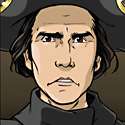
Sir William Howe was the youngest of three Howe brothers, all military men who served in the Seven Years War. Howe was sent to America to aid General Gage in the fighting with the Americans, but after a horrible defeat at Bunker Hill (the British suffering 1,000 casualties), Gage was recalled from his position, sent back to Britain and replaced with Howe. The Americans kept Howe’s army bottled up in Boston for nearly a year, and the city full of refugees came dangerously close to running out of food and supplies. When the Americans built defenses on Dorchester Heights, an advantageous position within firing range of the city, Howe chose to abandon the Boston to pick up the fight elsewhere. He brought his troops to New York City where he met up with his brother, the Admiral of the Navy, Lord Richard Howe. Together, with their massively intimidating fleet of British warships, they sat circling Manhattan, waiting for the opportune time to start–and hopefully finish–the fight.
- Anti-Villain
- Big Bad
- Cultured Warrior
- Historical Domain Character
- Just Following Orders
- Punch Clock Villain
- Red Eyes, Take Warning
Mrs. Betsy Loring
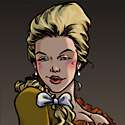
Betsy Loring married into a prestigious family of British loyalists in Boston, but American Patriots raided her father-in-law’s house in the country forcing the Lorings to flee for the city. The British Commander in Chief, General Gage, gave her father-in-law a generous appointment in the army to make up for the financial losses caused by the rebel mob. They settled into a home not far from the British headquarters, and from here Betsy noticed General William Howe who had just arrived from England. He shared her favorite vices–a fondness for wine, gambling, and pleasure. After just a few weeks she became his mistress, following him wherever the British forces moved, and, not one to miss a financial opportunity, her husband, Joseph Loring, followed them, too – to receive his hush money which he all too quickly gambled away.
- Back to The Dreamer